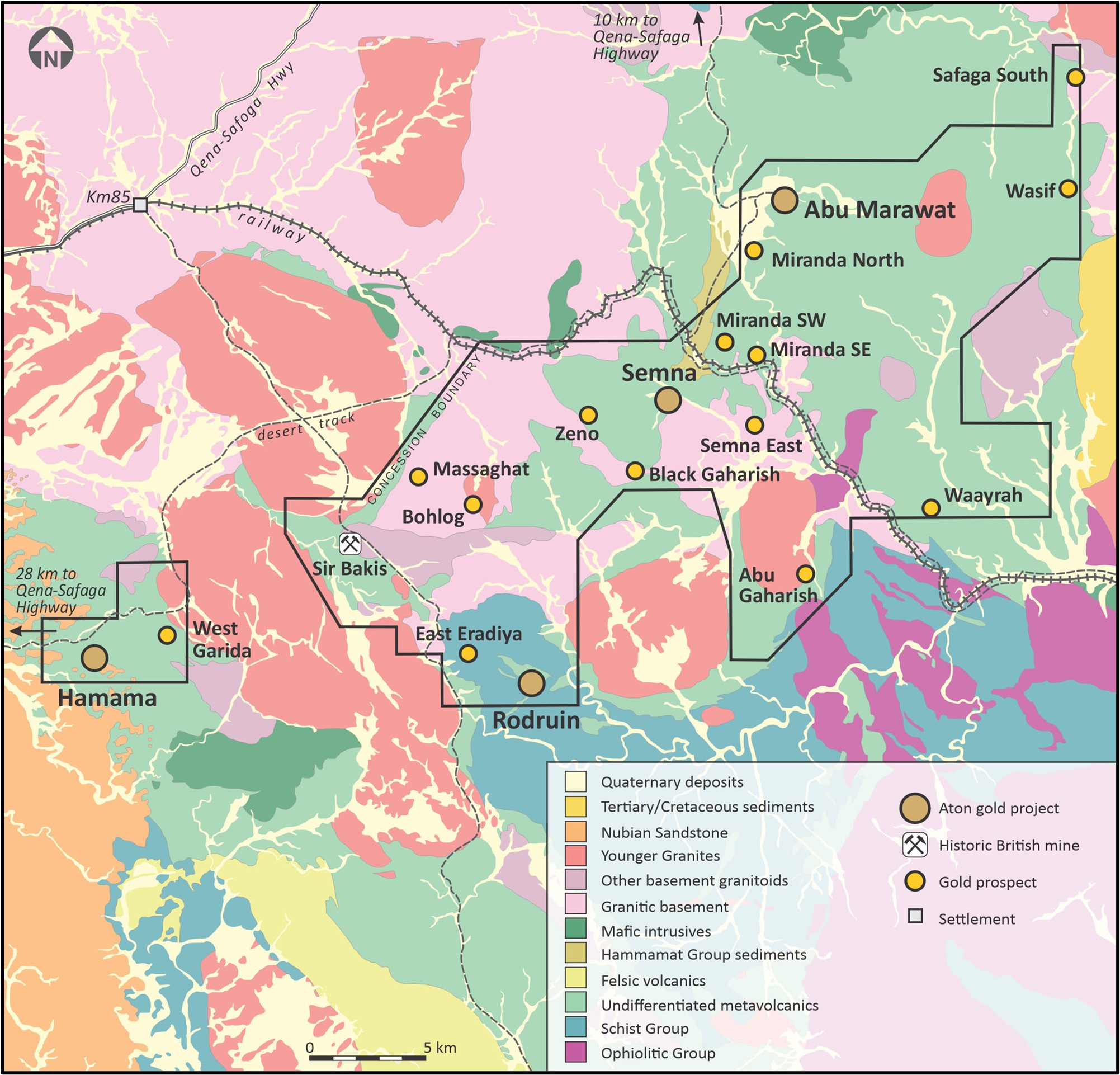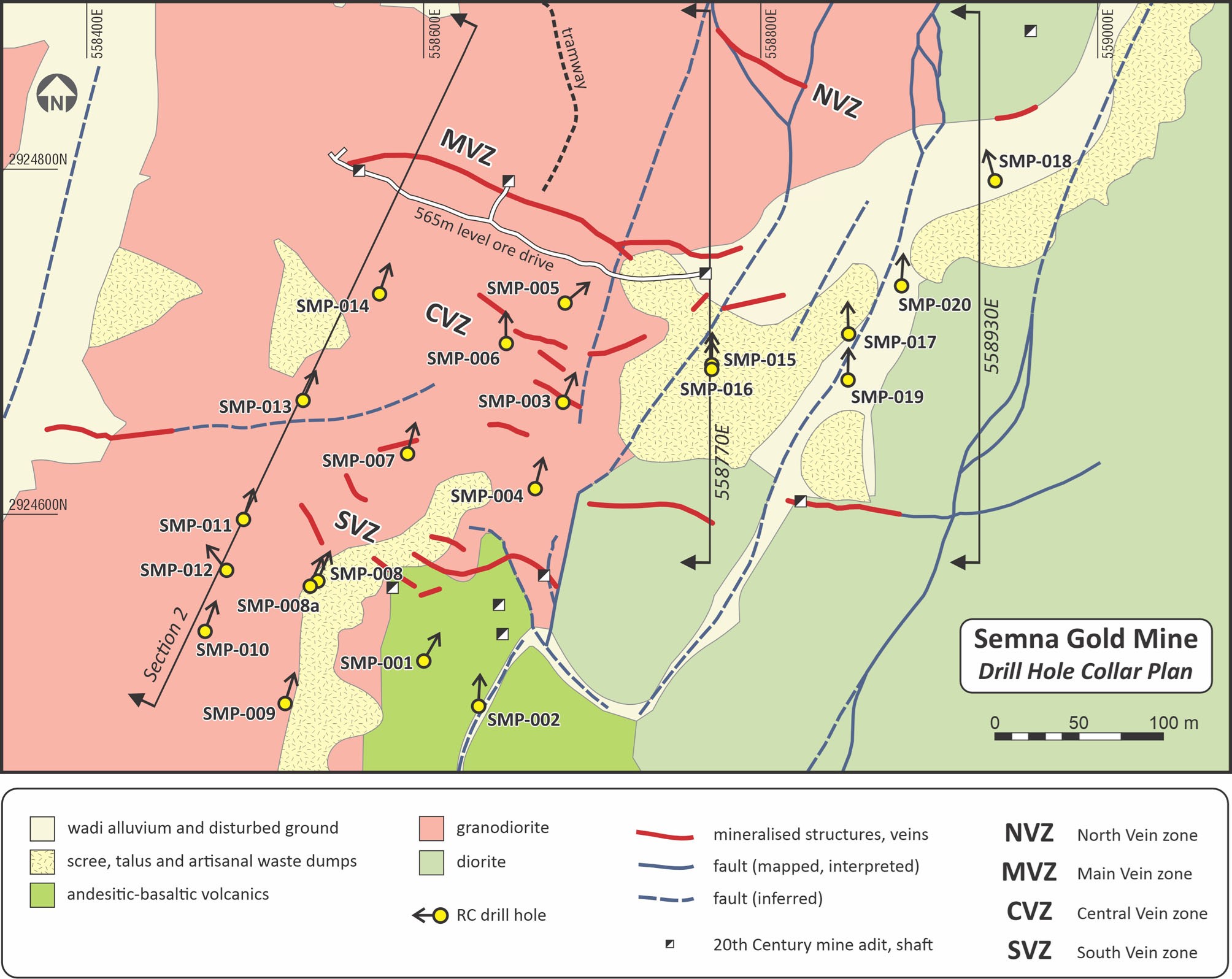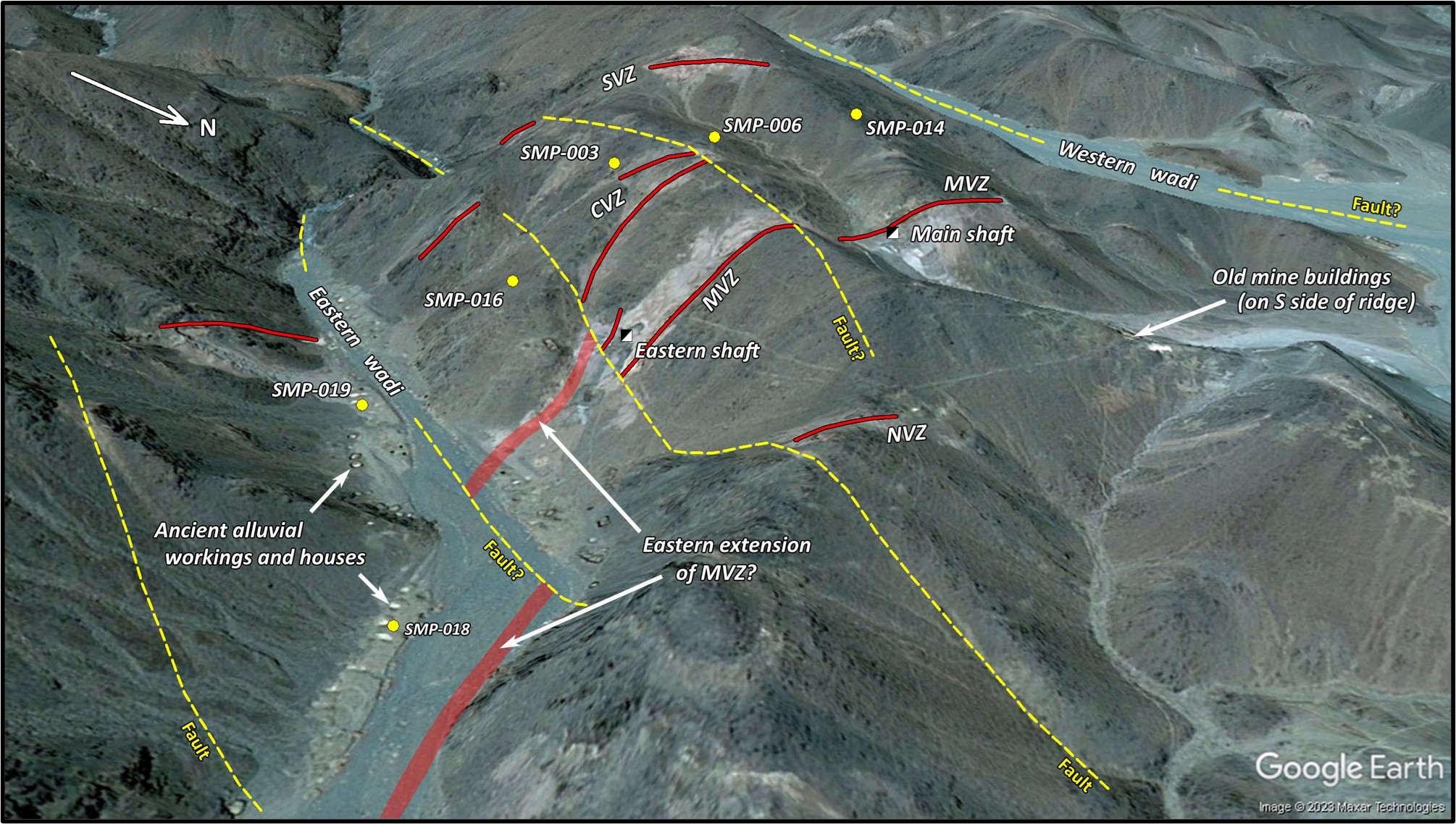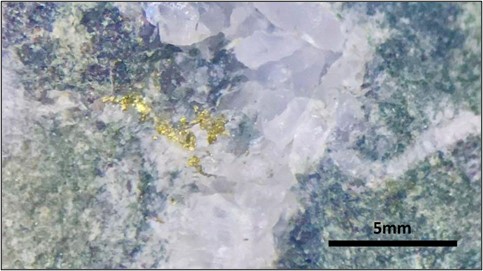from Aton Resources, Inc. (isin : CA0496AP2026)
Aton Reports the Final RC Drill Results from its New Semna Drill Discovery, Including 50.07 g/t Au Over an Interval of 6 Metres from Drill Hole SMP-016
VANCOUVER, BC / ACCESSWIRE / December 18, 2023 / Aton Resources Inc. (TSX-V:AAN) ("Aton" or the "Company") is pleased to update investors with the final results from its reverse circulation percussion ("RC") drilling at the Semna gold mine prospect, located within its 100% owned Abu Marawat Concession ("Abu Marawat" or the "Concession"), in the Eastern Desert of Egypt.
Highlights:
- 21 holes were drilled at the Semna prospect, for a total of 3,662m, with the preliminary drill results from 4m composite sampling having previously been reported (see news releases dated October 13, 2023 and November 7, 2023);
- Assay results of the primary 1m split samples through the mineralised zones are now available, and show good correlation with the 4m composite sampling;
- Significant high grade mineralised intersections from the Semna Main Vein zone ("SMV") include:
- 50.07 g/t Au over a 6m interval, from 75m downhole depth (hole SMP-016), including 222 g/t Au over 1m, from 80m;
- 28.36 g/t Au, 28.4 g/t Ag and 1.15% Cu over a 4m interval, from 136m downhole depth (hole SMP-003), including 94.8 g/t Au, 88.2 g/t Ag and 3.47% Cu over 1m, from 137m;
- 11.98 g/t Au over a 16m interval, from 61m downhole depth (hole SMP-018), including 36.03 g/t Au over 4m, from 61m;
- 10.61 g/t Au, 24.0 g/t Ag and 1.20% Cu over a 9m interval, from 130m downhole depth (hole SMP-019), including 37.00 g/t Au, 145.0 g/t Ag and 8.72% Cu over 1m, from 133m. SMP-019 also returned intersections of 5.82 g/t Au over a 3m interval from 102m, and 9.10 g/t Au over a 2m interval from 111m.
- 5.73 g/t Au over a 14m interval, from 56m downhole depth (hole SMP-017), including 14.85 g/t Au over 3m from 60m, and 8.67 g/t Au over 3m from 66m.
"We are pleased to be able to now provide the final assay results from the Semna RC drilling programme. It is quite apparent to us, even at this early stage, that Semna is shaping up as a very significant new drill discovery. We plan to fast-track the exploration at Semna as soon as the mining licence has been issued at Abu Marawat, which we anticipate will be very soon now. Preparations are already well advanced to start a second phase of diamond drilling, and if all goes according to plan we expect to be back drilling again at Semna in January 2024." said Tonno Vahk, Interim CEO. "We started this year with the overriding objective of completing our submission to EMRA, to demonstrate the existence of a Commercial Discovery at the Hamama West and Rodruin deposits, which under the terms of our Concession Agreement with EMRA, is the most significant step on the road to the mining licence at Abu Marawat. We delivered our submission to EMRA in August, we believe that we are now very nearly there, and we are looking forward to working closely with EMRA as we move forwards together once the mining licence has been issued. 2023 has been a year of great progress for Aton, and we close the year with these exceptional drill results from our new Semna discovery. These results again further illustrate the undoubted potential of the Abu Marawat Concession to host multiple economic gold deposits. With the anticipated issuance of the mining licence we look forward to being able to finally start realising the full potential of the Concession, as we move towards the development of multiple gold mining operations at Abu Marawat, starting in 2024."
Semna Prospect
The Semna prospect is located approximately 27km east-northeast of the Hamama West deposit and 13km north-northeast of the Rodruin deposit, and is accessed via desert tracks from either Hamama, Rodruin or the Abu Marawat deposit to the north (Figure 1). The Semna area has a long history of gold mining, during both ancient and modern times. Archaeological evidence suggests that mining dates back as far as the Old Kingdom period, over 4,500 years ago. In modern times, Semna was exploited between 1904 and 1906 by two British companies, which worked the Main Vein on two underground levels. There was also some further development work carried out at Semna in the 1950's by a subsidiary of the Egyptian Phosphate Company.

Semna gold mine RC drilling
21 drill holes, SMP-001 to SMP-020, were completed at the Semna prospect, for a total of 3,662 metres during the recent RC drill programme (Figure 2). Collar details pf the holes and the results of 4m composite sampling have been previously reported (see news releases dated October 13, 2023 and November 7, 2023). Based on the results of the 4m composite sampling a total of 310 primary 1m split samples through the interpreted mineralised zones were selected and submitted for gold, silver, copper, lead and zinc geochemical analysis. These results are now reported herein.

Full final intersection details from the 1m split samples are provided in Appendix A, and a comparison with the original 4m composite sample intersections from the Main Vein zone ("MVZ") is provided in Appendix B. Selected intersections from the MVZ, which was mined during the 20th century, and has more recently been exploited both at surface and from underground by artisanal miners (see news release dated October 13, 2023) are provided in Table 1.
Holes SMP-001 to SMP-014 were drilled on 3 north-northeast sections across the MVZ, the Central Vein zone ("CVZ"), and the South Vein zone ("SVZ"), see Figure 2. Holes SMP-015 and SMP-016 were drilled on a northerly section at the now exposed eastern end of the 20th century workings, and holes SMP-017 to SMP-020 were drilled to test a postulated eastern extension to the MVZ ("MVZ-EX").
Sporadic narrow mineralisation was intersected from the CVZ and the SVZ. Assay results from the SVZ were unexpectedly low, in light of the presence of old 20th century and the large recent artisanal workings on this zone. More consistent narrow zones of low to moderate grade mineralisation were intersected on the CVZ, for example in holes SMP-003, SMP-006 and SMP-014. The North Vein zone ("NVZ") was not tested in the phase 1 RC drill programme.
Significant mineralised intersections were returned from the MVZ and the MVZ-EX extension zone (see Table 1 and Appendix A), including 50.07 g/t Au over a 6m interval, from 75m downhole depth (hole SMP-016), 28.36 g/t Au, 28.4 g/t Ag and 1.15% Cu over a 4m interval, from 136m downhole depth (hole SMP-003), 11.98 g/t Au over a 16m interval, from 61m downhole depth (hole SMP-018), and 10.61 g/t Au, 24.0 g/t Ag and 1.20% Cu over a 9m interval, from 130m downhole depth (hole SMP-019. Hole SMP-019 also returned intersections of 5.82 g/t Au over a 3m interval from 102m downhole depth, and 9.10 g/t Au over a 2m interval from 111m, indicating the presence of multiple mineralised structures in the MVZ-EX. Schematic interpretations of cross sections 2, 558770E and 558930E are provided in Appendix C.
Hole ID | Section ID | Intersection (m) | Au (g/t) | Ag (g/t) | Cu (ppm) | Comments | ||
From | To | Interval | ||||||
SMP-003 | Section 4 | 136 | 140 | 4 | 28.36 | 28.4 | 11,481 | |
incl. | 137 | 138 | 1 | 94.80 | 88.2 | 34,750 | ||
SMP-004 | Section 4 | 184 | 186 | 2 | 12.45 | 1.5 | 75 | open at depth below |
SMP-006 | Section 3 | 116 | 118 | 2 | 14.20 | 2.8 | 65 | |
SMP-007 | Section 3 | 155 | 157 | 2 | 9.74 | 2.3 | 69 | open at depth below |
SMP-013 | Section 2 | 186 | 189 | 3 | 4.93 | 0.7 | 50 | open at depth below |
SMP-014 | Section 2 | 109 | 114 | 5 | 4.14 | 0.6 | 19 | |
SMP-015 | 558770E | 50 | 52 | 2 | 5.05 | 0.6 | 25 | hangingwall structure |
and | 78 | 81 | 3 | 7.11 | 3.4 | 551 | MVZ structure | |
SMP-016 | 558770E | 75 | 81 | 6 | 50.07 | 6.7 | 1,026 | hangingwall structure, open at depth below |
incl. | 80 | 81 | 1 | 222.0 | 23.2 | 207 | ||
and | 134 | 142 | 8 | 2.39 | 1.8 | 801 | MVZ structure, open at depth below | |
incl. | 139 | 141 | 2 | 7.10 | 1.7 | 105 | ||
SMP-017 | 558850E | 56 | 70 | 14 | 5.73 | 1.5 | 198 | multiple mineralised structures / veins |
incl. | 60 | 63 | 3 | 14.85 | 2.7 | 113 | ||
and incl. | 66 | 69 | 3 | 8.67 | 3.1 | 521 | ||
SMP-018 | 558930E | 61 | 77 | 16 | 11.98 | 2.0 | 46 | most northeasterly intersection - open to NE and at depth below |
incl. | 61 | 65 | 4 | 36.03 | 5.9 | 122 | ||
SMP-019 | 558850E | 102 | 105 | 3 | 5.82 | 8.9 | 259 | multiple mineralised structures / veins, open at depth below |
and | 111 | 113 | 2 | 9.10 | 6.2 | 624 | ||
and | 126 | 127 | 1 | 2.28 | 0.9 | 41 | ||
and | 130 | 139 | 9 | 10.61 | 24.0 | 12,038 | ||
incl. | 130 | 134 | 4 | 19.78 | 43.6 | 22,091 | ||
and incl. | 133 | 134 | 1 | 37.00 | 145.0 | 87,240 | ||
Table 1: Selected final intersections from the Semna MVZ
7 holes targeted the MVZ beneath the old 20th century workings (see Figure C1), on approximately 80m spaced drill sections, specifically SMP-003, SMP-004, SMP-005 (Section 4), SMP-006, SMP-007 (Section 3), and SMP-013 and SMP-014 (Section 2, Figure C1). The old workings have recently been extended down to an approximate elevation of 550m RL by the artisanal miners (see news release dated October 13, 2023). All holes, except SMP-005 which intersected sub-grade mineralisation, returned mineralised intersections with true widths of between approximately 2 and 4 metres, grading between 4.14 g/t Au (5m interval from hole SMP-014) and 28.36 g/t Au (4m interval from hole SMP-003). Individual 1m samples from this area returned assays including 94.8 g/t Au (hole SMP-003), 25.7 g/t Au (SMP-006) and 17.75 g/t Au (SMP-007). The drilling confirmed the continuity of the mineralisation beneath the mined out upper parts of the MVZ. The MVZ continued at an average dip of approximately 70° to the SSW, although the zone appears to shallow in the deepest holes. It is not clear if this is due to the MVZ actually shallowing, or if it is due to the presence of multiple en echelon mineralised structures (Figure C1). The mineralisation on the MVZ was open at depth on all sections beneath the old mine workings.
Holes SMP-015 and SMP-016 were drilled at the eastern end of the 20th century workings, close to the eastern shaft, where the MVZ appears to swing around to a more easterly or east-northeasterly orientation. The MVZ appears to be faulted out here, and surface mapping of the area, now exposed by the artisanal miners, suggests that the MVZ has been sinistrally displaced by approximately 40m to the southwest (Figures 2 and 3).


Holes SMP-015 and SMP-016 both intersected 2 discrete mineralised zones, with true widths of approximately 2-4m (Figure C2). The northern or footwall zone is interpreted as being the main MVZ, while the southern hangingwall zone is interpreted as being a separate structure striking approximately southwest which appears to join with the CVZ. Both mineralised zones dip at approximately 75° to the south. The hangingwall zone returned an intersection of 50.07 g/t Au over an interval of 6m (true width approximately 3m). Inspection of the drill chips indicated the presence of abundant coarse gold (Figure 4), with individual 1m samples from this 6m interval returning assays including 222.0, 40.8 and 20.3 g/t Au. Examination of blocks of mineralised rock from surface in this area also showed the presence of abundant coarse visible gold.
The final 4 holes of the programme, SMP-017 to SMP-020 were drilled to test a postulated eastern extension of the MVZ, running parallel to a "jog" in the eastern wadi (Figures 2 and 3), the so-called "MVZ-EX" zone. 3 of the holes returned wide zones of high grade mineralisation.
SMP-017 was drilled on a northerly azimuth on the 558850E section, and returned a mineralised intersection of 5.73 g/t Au over a 14m interval, from 56m downhole depth, and beneath it SMP-019 returned mineralised intersections of 5.82 g/t Au over a 3m interval, from 102m downhole depth, 9.10 g/t Au over a 2m interval from 111m, and 10.61 g/t Au over a 9m interval from 130m downhole depth (see Table 1 and Appendix A). Individual 1m samples from SMP-017 returned assays including 18.25, 13.8 and 16.25 g/t Au, while individual 1m samples from SMP-019 returned assays including 37.0, 22.6 and 15.6 g/t Au.
Hole SMP-018 was drilled slightly oblique to the 558930E section approximately 160m east of the underground mine workings, and was the easternmost hole in the programme. SMP-018 returned a mineralised intersection of 11.98 g/t Au over a 16m interval, from 61m downhole depth (see Table 1, Appendix A and Figure C3). This interval included individual 1m samples which returned assays including 51.8, 47.1, 24.1 and 21.1 g/t Au. In this locality the MVZ-EZ is interpreted as being approximately vertical, with a true width of approximately 10-12m. Hole SMP-020 was drilled on the 558890E section between the other holes (Figure 2), and is interpreted as having missed the MVZ-EX zone, which had here been offset by a NNE-striking fault.
Comparison of 1m split sample and 4m composite sample results
A comparison between all the final 1m split and 4m composite assay intersections is provided in Appendix B, and selected comparative intersections from the MVZ are provided below in Table 2.
Hole ID | 1m split samples | 4m composite samples | ||||||
Intersection (m) | Au (g/t) | Intersection (m) | Au (g/t) | |||||
From | To | Interval | From | To | Interval | |||
SMP-003 | 136 | 140 | 4 | 28.36 | 136 | |||

